Lean Validation: An introduction
Developing new business ideas can be an unpredictable endeavour, and without evidence-based foresight, the process can feel like you're flying blind. That's where Lean Validation comes in.
Whether your venture is B2B, B2C or D2C, conducting proper customer validation provides reliable proof that customers want your product or service, that you can build it, and that it's profitable—all before you make heavy investments in time, money or resources.
At Bundl, we validate our ventures using lean experimentation techniques that enable us to:
- Understand your product potential
- Get the answers we need fast
- Operate on a lean budget
- Adapt concepts based on real customer feedback
- Create killer business cases that unlock corporate funding
Let’s take a closer look at what this methodology entails, the different steps in the process and how to apply them to validate business ideas.
What is Lean Validation?
Lean Validation is a highly efficient methodology for testing business ideas with minimal resources before making major investments. It's based on “The Lean Startup” principles developed by Eric Ries and focuses on quickly validating or invalidating key assumptions about a business model, new feature, service or product.
Through systematic market validation, you'll get the feedback you need to:
- Make vital iterations
- Set adequate price points
- Refine your target audience
- Prove the offering will be profitable
Using lean experimentation techniques enables teams to decrease blind spots and move forward based on concrete evidence rather than assumptions. Think of it as a four-step process in which you’ll:
- Map critical assumptions
- Design the experiment
- Test your assumptions
- Gather and analyse your insights
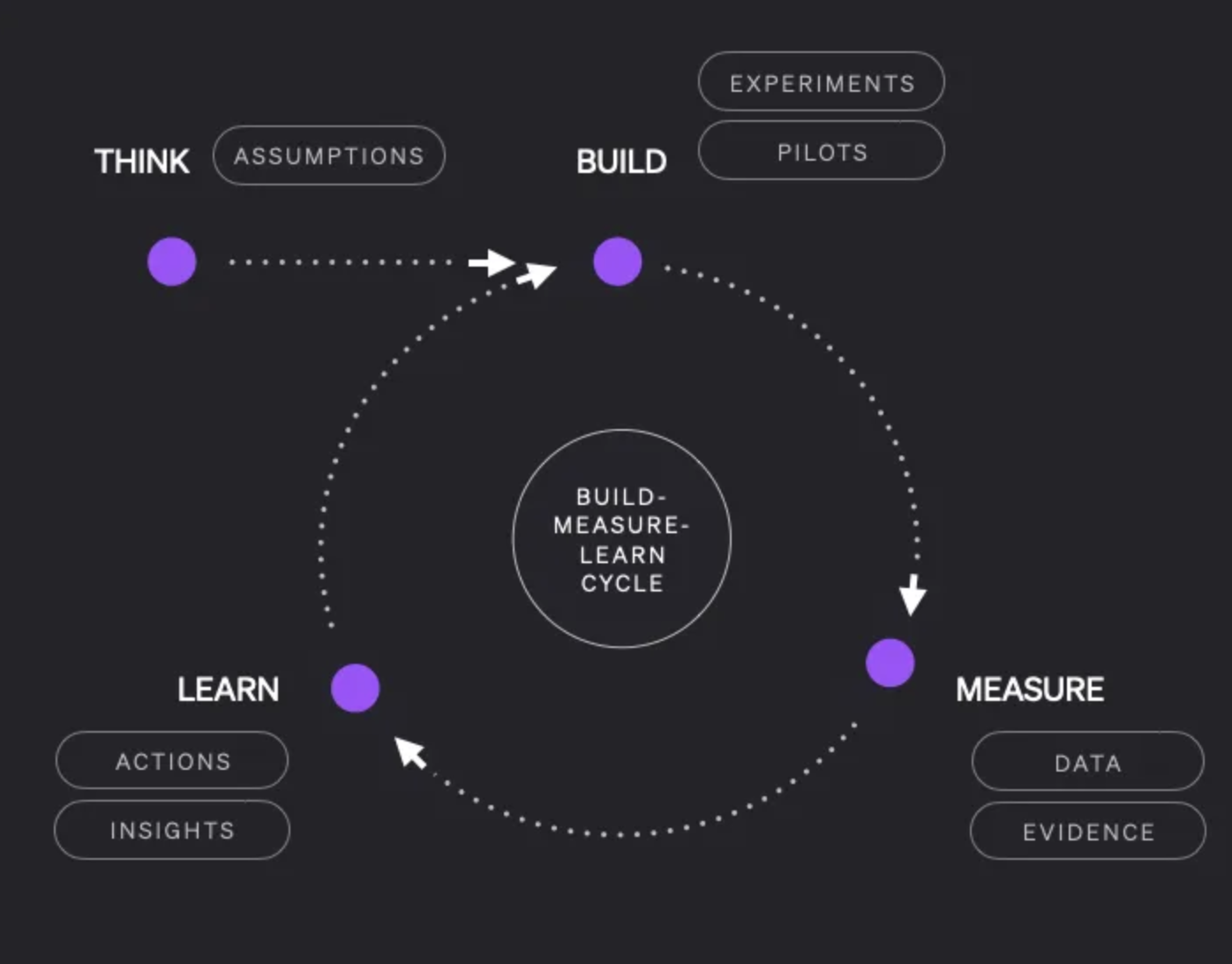
Depending on the outcome, you’ll know whether to make adjustments, move forward or cut your losses and move on to the next project. Having these answers beforehand can potentially save you millions in misdirected investments, not to mention time, effort and valuable resources.
The four pillars of Lean Validation
Before diving into the validation process, it's important to understand the four fundamental pillars of successful business idea validation: Desirability, feasibility, viability and responsibility.
Let’s explore each pillar individually:
1. Desirability (aka Customer Validation)
This pillar focuses on understanding your target audience, validating their pain points, and ensuring your solution meets their expectations. It's about answering the question: Do customers truly desire this product?
It can involve:
- Social listening on social media and product reviews to understand usage patterns and preferences to sense desirability
- Talking with consumers in interviews or surveys to capture their frustrations and unmet needs
- Capturing consumer's true behaviour by building a Minimum Viable Product (MVP) to gauge interest
2. Feasibility (aka Technical Validation)
Even the most exciting idea falls short if it can't be executed effectively. Feasibility ensures you have the operational and technical capabilities to deliver on your promise. It answers the question: Can we actually build and maintain this solution?
It can involve:
- Assessing your technical capabilities and resource requirements
- Testing development processes and production methods
- Validating scalability and implementation timelines
3. Viability (aka Business Model Validation)
The viability pillar tests whether your business model is profitable and sustainable in the long run. It answers the question: Can we build a successful business around this?
It can involve:
- Testing different pricing strategies and revenue models
- Validating cost structures and profit margins
- Exploring your market size and growth potential
4. Responsibility (aka Impact Validation)
The responsibility pillar examines whether your concept aligns with social and ethical standards. It encourages consideration of environmental sustainability, inclusivity, and overall societal benefit. It answers the question: Should we build this solution?
It can involve:
- Assessing environmental impact and sustainability
- Ensuring the product or service is accessible to diverse audiences
Systematically testing each pillar through proper lean validation will enable you to build a strong foundation for your venture, increasing its chances of success.
What is customer validation?
Customer validation is a critical phase in product development where you verify that your target customers exist, that they have the problem you're trying to solve, and that they're willing to pay for your solution. It helps development teams answer questions about their new product, service or feature.
Here are just a few examples:
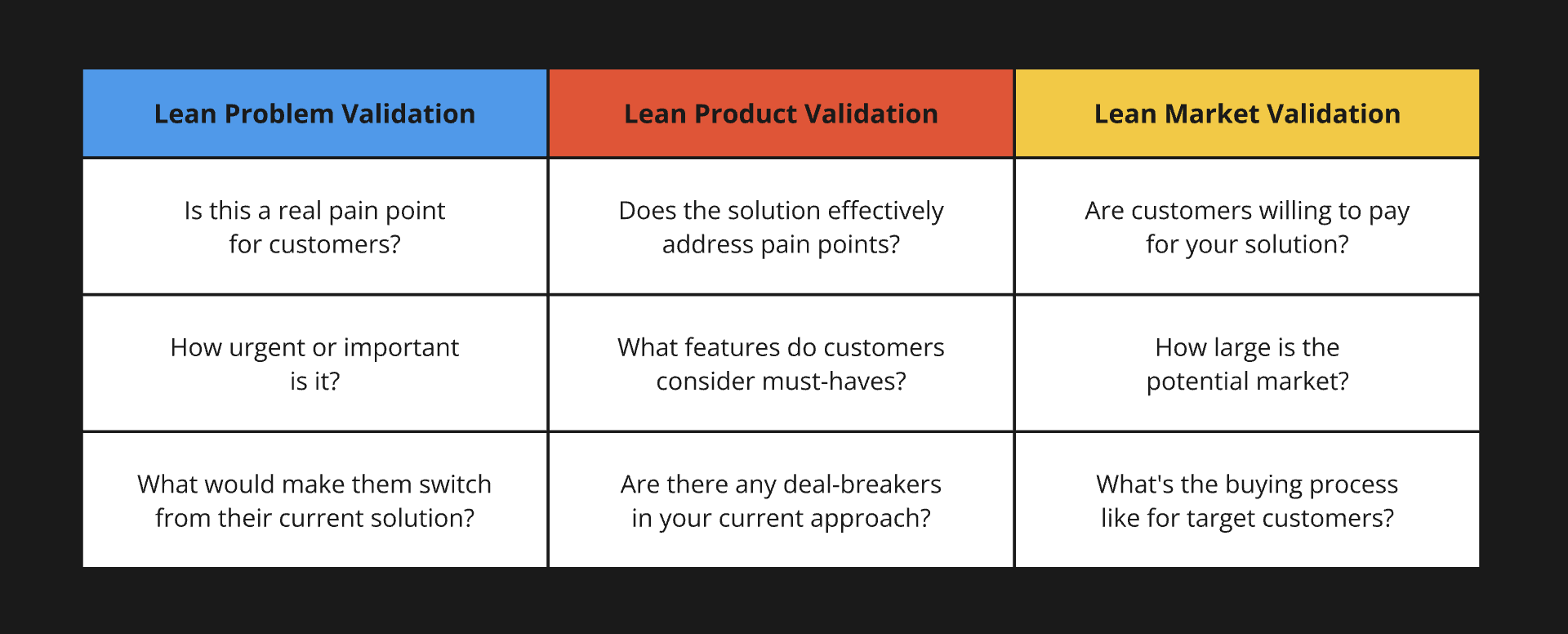
Here are a few tips to help guide you through the process:
- Focus on specific segments: Don't try to validate with everyone at once
- Ask the right questions: Focus on past behaviour rather than future intentions
- Look for patterns: Individual feedback is helpful, but patterns are more reliable
- Document everything: Keep detailed records of all customer interactions
- Stay objective: Don't let confirmation bias affect your analysis
What is a validation sprint?
A validation sprint is a focused effort, lasting about 1-2 weeks, in which development teams validate key assumptions about a product, service, or feature before committing to full development.
The goal of a validation sprint is to build a series of experiments that will confirm or reject any unknown assumptions about your new product, service or feature. For example, let’s say you have a promising new venture idea, but you need solid data before you can secure the investment you need to get your project up and running.
In this case, a validation sprint is the most efficient way to get reliable proof that your venture concept is reliable, feasible, viable and responsible. Here are some additional reasons to run a validation sprint:
- To get data-driven validation on your early-stage business concept
- To identify and list your most critical assumptions
- To validate or invalidate these assumptions
- To gather useful information about your target audience
- To put the finishing touches on your prototype, product or service in a way that is fast, lean and efficient
Some of the key activities involved in a validation sprint include:

In short, validation sprints enable teams to identify potential bottlenecks, issues or failures by gathering insights from real users or stakeholders to guide the process moving forward (e.g. build, pivot or kill). This could save a significant amount of valuable time and resources, ensuring a lean and efficient product validation process.
What are the five steps in the validation process?
There are five key stages involved in running a validation sprint, which can be spread over five days or more (depending on the complexity of the experiments involved):

Stage 1: Design
1. Formulate your assumptions
This involves pinpointing the assumptions you want to test, e.g.:
- Our chosen target audience will buy the product
- Our branding strategy creates the desired response among our customers
- Our business model is profitable
- Our audience's values are reflected in our offering
Once you've identified your assumptions, the next crucial step is mapping and prioritising them based on the factors below:
- Impact (High/Medium/Low): How important is this assumption to your success?
- Risk (High/Medium/Low): How uncertain are you about this assumption?
- Testability (Easy/Medium/Hard): How readily can you validate this?
Prioritise assumptions that have high impact and high risk but are relatively easy to test.
2. Choose your experiments
Your goal during this step will be to find creative ways to test and validate (or reject) the assumptions you mapped out during step one. You’ll be designing actual experiments to get the answers you need through various types of market research (e.g. face-to-face interviews, online surveys, smoke testing, etc.).
Ask yourself: What’s the most agile, efficient and low-cost way to reliably prove my assumptions?
Stage 2: Build
Now that your experiments have been designed, it’s time to start building! There are quite a few online tools you can use to help set up your experiments and automate your data-gathering process. Here’s a list of our favourites:
- For online surveys: Tally, SurveyMonkey, Maze, OnePulse
- For running interviews: Respondent, UsabilityHub, Lyssna
- For designing prototypes: Figma, Sketch, , Miro, ProtoPie
- For landing page design: Webflow, Squarespace, Wix, Wordpress
- For landing page tracking: Hotjar, Google Analytics, Mixpanel, Amplitude
Stage 3: Launch
Now that your experiments are set up, it’s time to go live and start monitoring your data. Before launching, make sure to:
- Set up your tracking infrastructure:
- Install analytics tools
- Configure event tracking
- Set up error monitoring
- Prepare for feedback collection:
- Create feedback forms
- Set up automated email responses
- Prepare interview guides
- Create a launch timeline with clear milestones and monitoring points.
Stage 4: Test
What happens during this phase largely depends on the type of experiments you and your team designed earlier. Your testing toolkit might include:
- Qualitative data gathering through user interviews and usability tests
- Quantitative data collection via A/B testing (using tools like Optimizely)
- User behaviour analysis through session recordings
- Heat mapping to understand user interactions
- Traffic generation through ad creation, online marketing campaigns and email campaigns for user engagement (using tools like Mailchimp).
For example, suppose you were able to schedule some face-to-face or telephone interviews beforehand. In that case, some of your time will go into gathering data directly from your target audience. The rest of your time will go into generating traffic for your landing page through ad creation and online marketing campaigns. Some useful resources include Google Adwords, social media ads and Mailchimp for drip campaigns.
Stage 5: Learn
Now, it’s time to reap the fruits of your labour. However, keep in mind that, depending on the scope and depth of your experiments, it can take up to 3 weeks before you’re able to gather any conclusive data. Here are some of the key questions you should tackle during this phase:
- Which experiments were successful?
- Which commercial story and target audience should you pursue?
- What are the next steps for the venture, and what resources are needed?
What is a validation canvas?
A validation canvas is a strategic planning tool that helps teams organise and visualise their key assumptions, experiments, and learnings during the validation process. It provides a structured framework for testing business ideas and product concepts efficiently.
Using a canvas during the validation process can be useful because it:
- Provides a clear structure for testing ideas
- Helps teams stay focused and aligned
- Makes assumptions explicit and testable
- Creates a shared reference for decision-making
If you’re having trouble getting started, be sure to add a validation canvas to your tool arsenal.
How to choose the right validation experiments
A good way to begin is by defining what success would look like for each of your assumptions (e.g. What outcome would give you the confidence to move forward?). Then, set up an experiment to measure how close you are to the desired outcome. Here's a quick two-step framework to help guide you through the process:
Step 1. Consider the type of risk you're testing
Different assumptions carry different types of risk that require specific validation approaches:
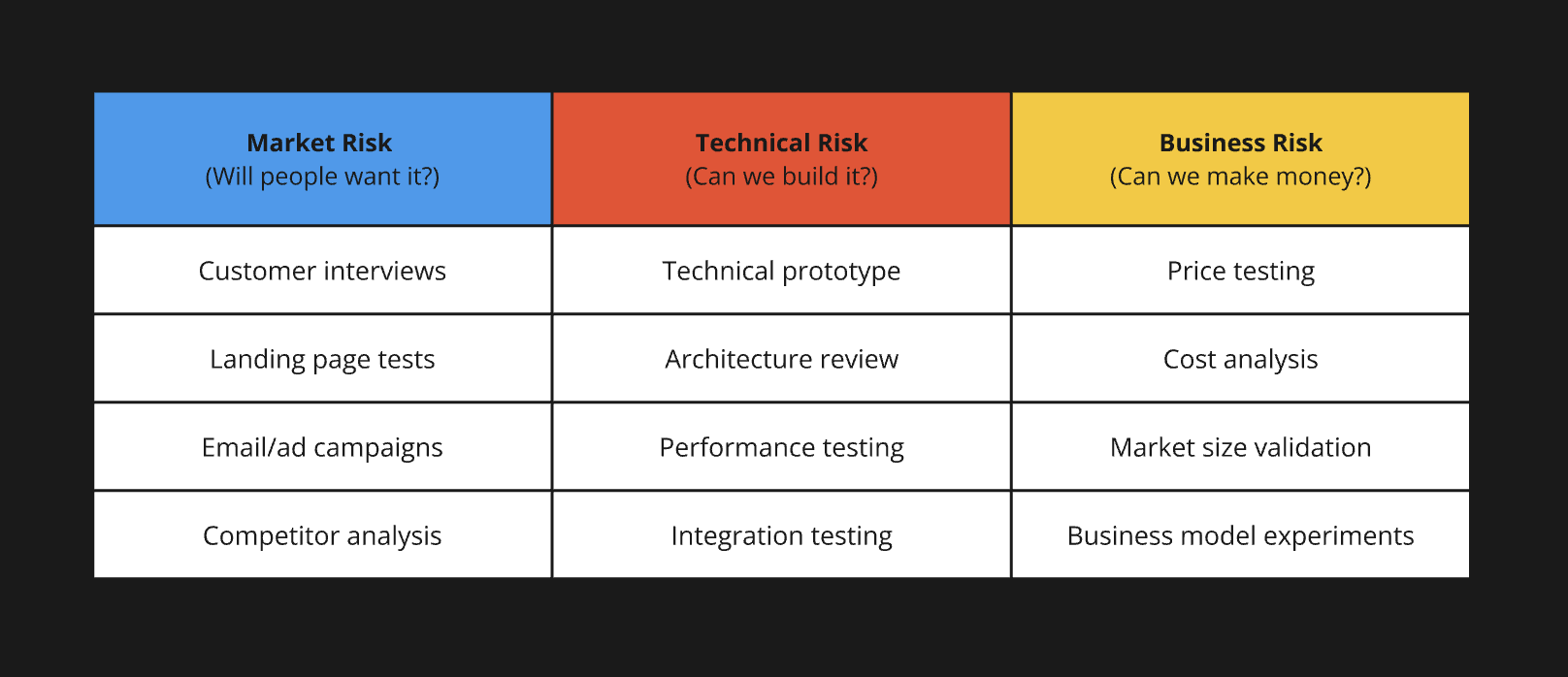
Step 2. Match your experiments to your venture stage
Choose experiments based on where you are in your product journey:

Pro tips:
- Start cheap and fast: Use low-cost experiments that can quickly test risky assumptions.
- Measure behaviour, not opinions: What people do is more reliable than what they say.
- Test one assumption at a time: Don't muddy your results by testing multiple variables.
- Set clear success criteria: Define what success looks like before running the experiment.
What is a smoke test?
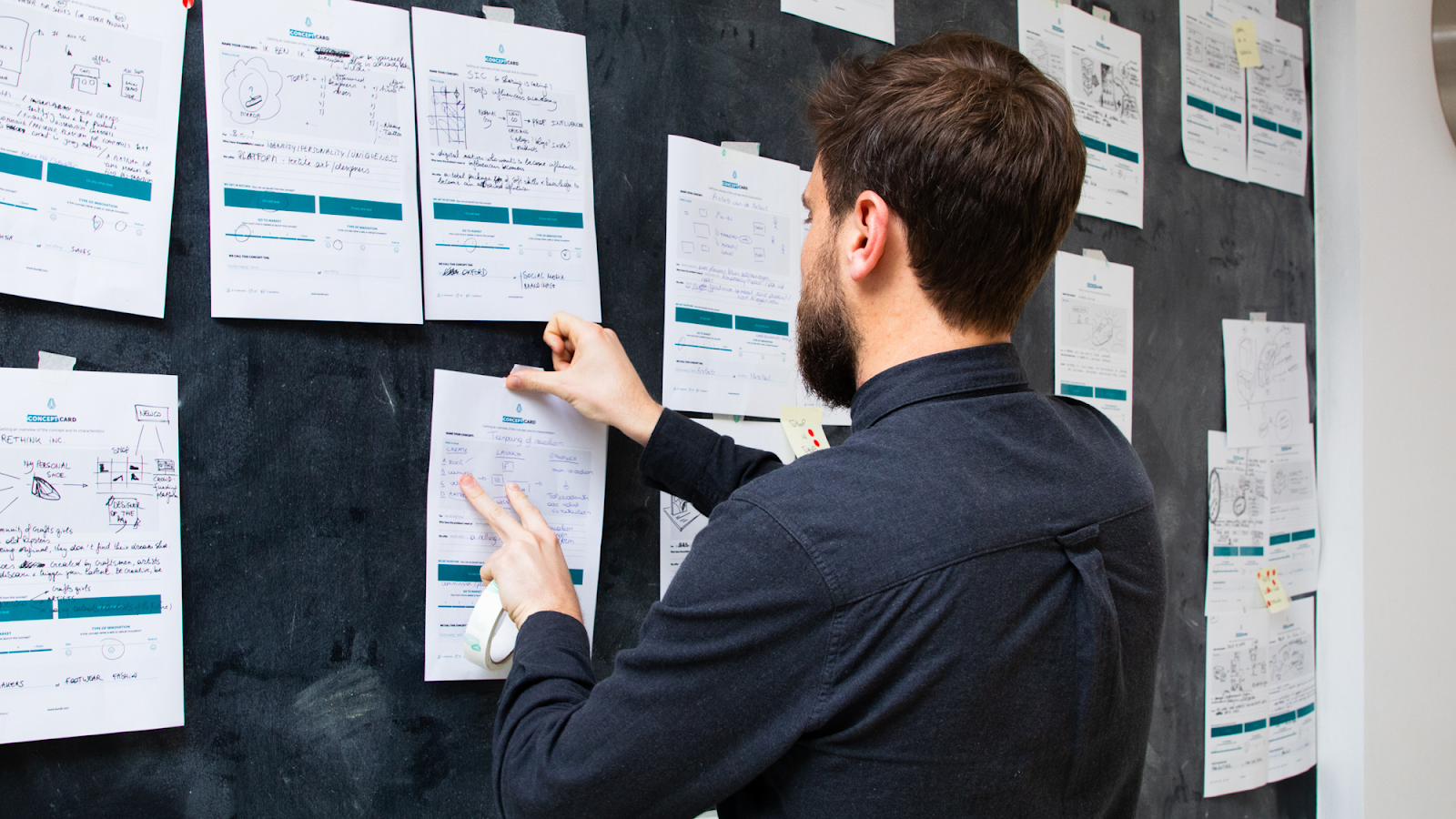
Smoke testing is a technique that enables you to gather real-world market demand data on your product or service idea as if it were ready for launch (even if that’s not yet the case).
It involves creating a website for your product or service, complete with images, product specs, and, most importantly, a buy button. Consumer tracking tools will also play a key role, providing valuable data on customer behaviour and preferences.
The goal of a smoke test is to find out how many people will end up clicking the “buy” button, showing proof of their actual intent to buy your offering. In the end, you’ll have the answer to a very important question: Is this concept commercially viable?
Here’s a brief outline of the steps involved:
Step 1. Create a value proposition with Unique Selling points
A unique selling point or USP goes further than coming up with a product or service idea. It refers to the exclusive added value/key benefits your customer gets when buying your product.
Having a strong USP usually means you’ve already:
- Empathised with your customer
- Identified a problem you want to solve
- Researched your competition
- Found a unique proposition in your space
Step 2. Build a website that explains and sells your idea
Smoke Test websites are built as a “prop” to help gather intelligence on buyer intent. You’re basically creating a space where you can track and study the behaviour of your potential clients.
There are plenty of drag-and-drop website builders that provide beautiful templates. Any of these platforms will do quite nicely:
- Wix.com
- Squarespace.com
- Instapage.com
Step 3. Set Up the right tracking tools for market validation
Once your website is ready, it’s time to start gathering some sweet data. Here are two essential metrics you’ll need to focus on:
- Number of website visits
- Number of people who clicked on your CTA button
One of the easiest tools you can use for tracking is VWO insights. Additional tools like VWO’s “heat maps” or Hotjar can be useful to help you track client behaviour inside your website.
Step 4. Use digital marketing tools to attract potential clients to your website
Knowing your audience will take you a long way in terms of creating effective ads that will generate traffic. Here are some useful pointers to get you started:
- Study how other industry players advertise similar products and services
- Find out who’s already paying money to use them
- Put some thought into your key demographic (e.g. age, language and location)
- Research the “high intent keywords” commonly used to find similar products or services
Useful tools during this stage include:
- Google Adwords
- Facebook ads
- Drip campaigns (but don’t spam – make sure to use an email list)
Paid channels like Google and Facebook ads are great because they’re easy to set up and allow you to work with your own budget.
For more handy tips on how to run your own smoke test, check out our video smoke test tutorial.
D2C and B2C vs B2B ventures
The process for validating a venture changes depending on the model you’ll be using (e.g. B2B, B2C, D2C). For example:
- For B2B product idea validation, sometimes having one big client write a letter of intent is enough to prove viability
- For B2C and D2C product idea validation, one customer isn’t enough. You’ll need a full customer base, so a smoke test would make more sense
Let's take a closer look at some of the key differences and how they impact your validation process.
How to validate D2C and B2C ventures
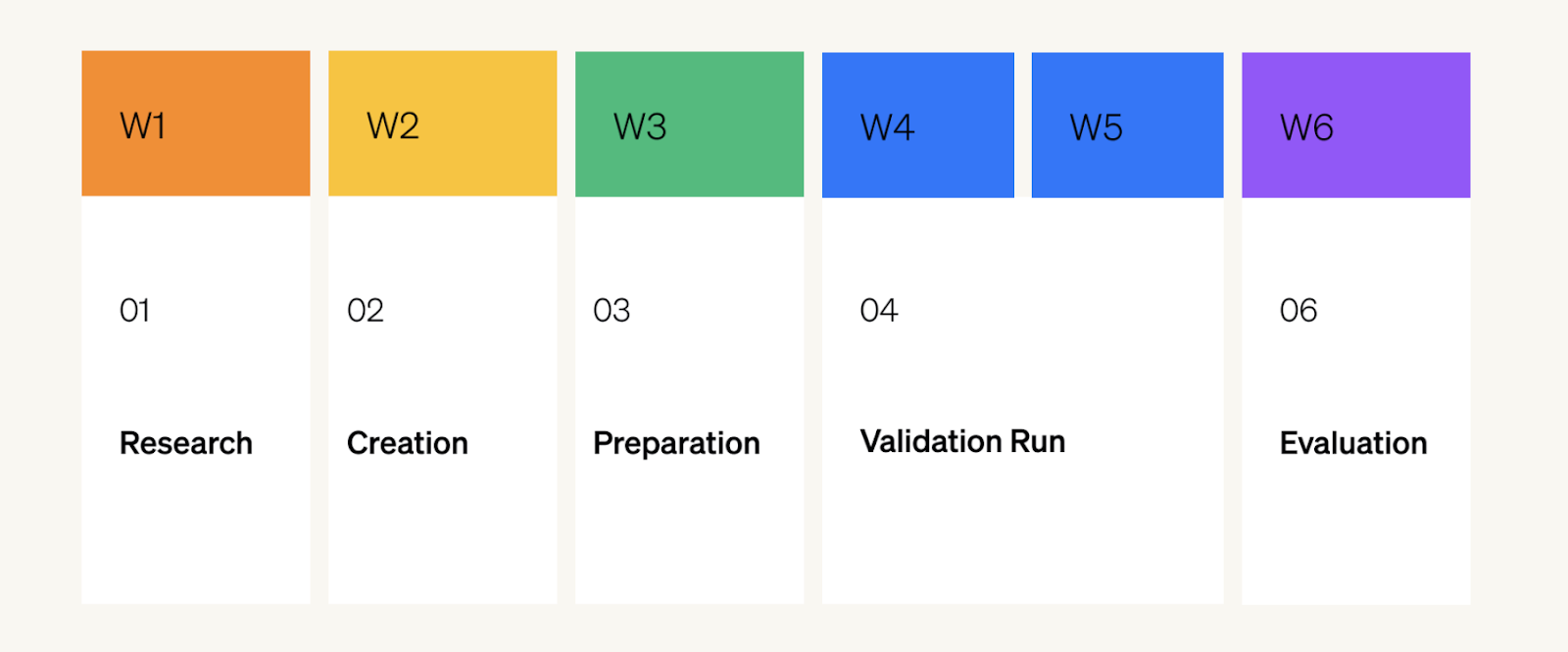
You can validate your D2C venture in as little as six to eight weeks following the right steps. Here’s a quick outline:
Week 1: Research
During this step, you’ll be researching things like new market trends, strategic business insights and target audience personas. Knowing what’s going on in the market and the needs and preferences of your potential customers will help you formulate solid assumptions to be tested later in the process.
Here are some of the key questions you should tackle before moving on to the next step:
- What does the customer journey look like?
- How are competitors selling a similar product/service?
- Could we get inspiration from other industries?
Week 2: Creation
During this step, you’ll be turning your ideas into detailed concept mockups, complete with pricing structures and messaging, ready to be validated with potential customers. By the end, you should have a complete assumptions map to help set up your experiments in the next step.
Here are some of the key questions you should tackle before moving on:
- Which value props can we build, starting from the current information?
- Which assumptions need to be validated?
- How can we validate the assumptions?
Week 3: Preparation
During this step, you’ll be creating tangible experiments to validate your D2C venture. Here are some of the key questions you should tackle before moving on to the next step:
- How do we reach our target audience best?
- What tool will provide us with the most reliable data?
- Who will execute the experiments?
Weeks 4 & 5: Validation run
During this step, you’ll be gathering customer feedback on things like:
- Price point
- Buyer intent
- Cost-per-click
- Click-through rates
- Preferred features
Based on the insights gathered, you can update your value proposition, business case and go-to-market pitch.
Week 6: Evaluation
The goal during this step is to evaluate the results of the validation, set up the next steps of the venture idea, and craft a compelling pitch narrative, concluding in a detailed “ask” for your funding and resources.
Here are some of the key questions you should tackle before moving on:
- Which experiments were successful?
- Which commercial story and target audience should you pursue?
- What are the next steps for the venture, and what resources are needed?
By the end of your six-week track, you’ll have gathered enough information to know what your next step should be:
- Build - Your results show great promise, and you’ll be moving forward with your venture.
- Pivot - The data shows you’ll need to make some changes before launch.
- Kill - Your results show low interest, and it’s time to move on to new projects.
How to validate B2B ventures
Validating a B2B venture can be a tricky and time-consuming process, requiring a more hands-on and qualitative approach than their B2C counterparts. That’s because, in most cases, your buyer isn’t your end-user. So, instead of getting feedback from a sea of potential customers, you’ll probably be able to count them on your fingers.
This changes some of your basic validation variables, making most canvases and techniques (e.g. Lean UX) unsuited without some tweaks and alterations. Having a smaller group of potential customers:
- Requires a more personal and detailed approach
- Makes it harder to test at a statistically significant scale
The good news is that once you know the nuances that make validating a B2C and a B2B venture different, you’ll be better equipped to get answers to questions like:
- Can my B2B product or service sell?
- Can my B2B concept be profitable?
- Is it feasible to build and bring it to the market?
- Does it align with the corporate strategy and ethics?
Check out our article on B2B venture validation for more details on how the process changes.
How to recruit B2B customers for concept validation
Finding the customers you need to validate B2C or D2C ventures isn’t always easy, but it’s cake compared to accessing B2B customers. For one thing, there just aren’t as many B2B customers in comparison to B2C. They’re also harder to access for a variety of reasons:
- You’re probably not the only one approaching them for an interview or review.
- Their time is usually limited.
- You’ll probably have to get past a gatekeeper before getting direct access.
To help you overcome some of these barriers, we’ve compiled a list of five tried and true tips you can use to find and recruit B2B customers to validate your venture.
- Join or create a group that’s relevant to your B2B customers
Join or create relevant groups on platforms like Facebook, LinkedIn and Slack, where you can interact with your target audience. Webinars are also a great place to start a conversation and connect with otherwise hard-to-access profiles. Here are a few helpful questions to ask yourself before you start your search:
- What kind of topics would my target audience be interested in?
- Is this group or webinar relevant for people who would be interested in my offering?
- Does this group or webinar address the pain points my product or service can solve?
Once you’ve found some groups to join, pay attention to the conversations, share your input on the subject and don’t be afraid to hit up interesting profiles for feedback.
- Use LinkedIn for targeted B2B profile searches
The LinkedIn Sales Navigator is a great tool for finding B2B profiles. Think of it as a huge B2B database that enables you to do targeted searches based on things like:
- company
- job title
- industry
- region
- size
- Keywords (just to name a few)
Although the service isn’t free, in many cases, it can be worth the money, especially if you do a lot of this type of validation.
- Reach your B2B audience with YouTube ads
With an ever-growing number of people using video content to keep themselves entertained, informed and up-to-date on various topics, YouTube ads are a great way to expand your reach. The trick is to narrow your audience down to a specific target audience that might find your offering compelling. Here are a few tips to get you started:
- Use keywords that are relevant to your product or service
- Use Google’s Geo-Targeting to run ads in specific areas
- Choose relevant video topics for your ads to appear on
- Test out different YouTube ad formats and see which works best
- Sites that provide user-generated content, like Reddit and Quora, can be a gold mine for finding niche audiences and early adopter
- Turn cold emailing into warm emailing
Cold email prospecting has been done to death in almost every industry, and most of them end up either getting deleted or in a spam folder. A great way to get past that hurdle is to add a bit of warmth and familiarity to the process. For example, you can start by getting on your B2B customer’s radar with:
- A targeted ad
- An introduction from a mutual contact
A little research also goes a long way in providing some common ground for conversation and discussion (e.g. published works, awards received, a recent promotion, etc.). Referring to these events in your email can also help break the ice (e.g. Congrats on your new promotion!) and increase your chances of engagement.
The role of AI in concept validation

AI is quickly transforming how teams can validate their products and services, making the process faster, more data-driven, and often more cost-effective. Here are just a few ways you can leverage AI to boost your validation process:
Market research and analysis
AI tools like ChatGPT, Claude and Perplexity can analyse vast amounts of market data, identifying trends and competitor insights that might take humans longer to compile. These tools can process multiple data sources simultaneously, providing teams with comprehensive market understanding in a fraction of the traditional time.
Customer research
There are AI tools supporting the planning, execution and analysis of both qualitative interviews, such as Conveo and Vurvey, and quantitative surveys, like OnePulse and SurveyMonkey.
Customer feedback analysis
AI Notetakers like Fathom and Krisp can transcribe and process interviews, saving you precious time in processing. Tools like Dovetail and Viable can rapidly organise and process thousands of customer comments, reviews, and survey responses, surfacing key themes and concerns that might otherwise be missed in manual analysis.
Prototype development
Tools like Midjourney, Recraft and DALL-E help teams quickly generate and iterate on design concepts, while AI-powered platforms like Figma and Miro can suggest design improvements and variations. This accelerates the testing process and allows teams to explore more options than traditional methods would allow.
However, it's crucial to remember that AI has its limitations, e.g.:
- It may not catch nuanced cultural or contextual factors
- Generated content almost always needs human review and refinement
- Some AI tools can be expensive for small teams
- AI insights should always be validated against real user feedback
For more insights about how to use AI during the validation process, be sure to check out our article: Generative AI in Corporate Innovation: The Pros, Cons, and Untapped Potential.
Final thoughts
Your validation results won’t always pan out the way you expect them to, and sometimes, you’ll have to iterate at various points in the process before reaching any meaningful results. It’s a trial-and-error technique that takes practice, creativity and a whole lot of patience.
It can be tempting to keep iterating and re-examining waning results but don’t fall into that trap. Stay unbiased and let the data guide your decision-making process. Depending on your results, you’ll either:
- Move forward with a validated concept
- Make some necessary adjustments before re-testing
- Cut your losses and move on to the next project
No matter how it turns out, you will have met your goal: To know if people will buy your product before investing time and resources into actually building it. In other words, you can’t really lose.
___
Lean validation can help you achieve a better product/market fit, reduce risk and unlock the funding you need to take your venture to new heights. We can help you validate your venture with real customers in as little as eight weeks.







